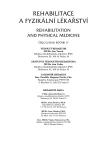Evaluation of Motoric Defects in Childhood
Authors:
P. Kolář; O. Horáček
Authors‘ workplace:
Klinika rehabilitace a tělovýchovného lékařství 2. LF UK a FN Motol, Praha
přednosta doc. PaedDr. P. Kolář, Ph. D.
Published in:
Rehabil. fyz. Lék., 17, 2010, No. 2, pp. 67-70.
Category:
Original Papers
Overview
A suitably selected and properly executed rehabilitation minimizes the disorder, compensates the limits in daily activities and makes the personal independence of somebody else’s help easier. In order to reach good therapeutic results it is necessary to look for parameters predicting therapeutic results, since response of patients’ population to therapy differs. There are various measurements and tests which make it possible to quantify the extent of motoric damage and consequences to functional ability. The testing methods used should meet basic conditions of objectiveness. The paper outlines basic functional tests, commonly applied in testing the degree of motoric damage.
Key words:
motoric damage, functional test, postural functions, locomotor functions
Sources
1. BOHANNON, R. W., SMITH, M. B.: Interrater reliability of a modified Ashworth scale of muscle spasticity. Phys. Ther., 67, 1986, s. 206–207.
2. BOYCE, W. et al.: The gross motor performance measure: validity and responsiveness of measure of duality of movement. Phys. Ther., 75, 1995, 7, s. 603-613.
3. GOWLAND, C. et al.: Reliability of the gross motor performance measure. Phys. Ther., 75, 1995, 7, s. 597-602.
4. KOLÁŘ, P.: Význam posturální aktivity pro včasný záchyt pacientů s dětskou mozkovou obrnou. Pediatrie pro praxi, 2001, 4, s. 190-194.
5. KOMAN, L. A. et al.: Management of spasticity in cerebral palsy with botulinum – A toxin: report of a preliminary randomized, double – blind trial. Journal of Pediatrics Ortopedics, 14, 1994, s. 394-412.
6. LIPPERTOVÁ-GRÜNEROVÁ, M.: Neurorehabilitace. Praha, Galén, 2005.
7. MAHONEY, F. I., BARTHEL, D.W.: Functional evaluation: The Barthel Index. Maryland State Medical Journal, 14, 1965, s. 61-65.
8. MASUR, H. et al.: Skalen und scores in der Neurologie. Quantifizierung neurologischer deficite in forschung und praxi. Stuttgart, Thieme, 1995, s. 339-340.
9. PEACOCK, W. J., STAUDT, L. A.: Functional outcomes following selective posterior rhizotomy in children with cerebral palsy. J. Neurosurg., 74, 1991, 3, s. 380-385.
10. PEACOCK, W. J., STAUDT, L. A.: Spasticity in cerebral palsy and the selective posterior rhizotomy procedure. J. Child. Neurol., 5, 1990, 3, s. 179-185.
11. RUSSEL, D. J. et al.: Gross motor function measure manual. 2nd ed. Hamilton, McMaster University, 1993.
12. TARDIEU, G., TARDIEU, C.: „Retraction”, „hypertony”, „hypotony”, „hyperextensibility”, „hypoextensibility”. Evaluation and therapeutic indications. The necessity of a factor analysis (author’s transl). Neuropsychiatr. Enfance Adolesc., 29, 1981, 11–12, s. 553–567.
13. VOJTA, V.: Mozkové hybné poruchy v kojeneckém věku. Praha, Grada Avicenum, 1993, ISBN: 80-85424-98-3.
14. VOJTA, V., PETERS, A.: Das Vojta Princip. Berlin, Heidelberg, New York, Springer Verlag, 2001, ISBN: 3-540-60576-2.
Labels
Physiotherapist, university degree Rehabilitation Sports medicineArticle was published in
Rehabilitation & Physical Medicine

2010 Issue 2
- Hope Awakens with Early Diagnosis of Parkinson's Disease Based on Skin Odor
- Deep stimulation of the globus pallidus improved clinical symptoms in a patient with refractory parkinsonism and genetic mutation
Most read in this issue
- Hallux Valgus from the Physiotherapist Standpoint or Is Hallux Valgus Just a Hallux Deformity?
- Evaluation of Motoric Defects in Childhood
- Effects of Treatment with Biosynchron 500 on Motor a Non-motor Symptoms in Patients with Parkinson Disease – Results of a Randomized Study
- Organization of Rehabilitation with Use of ICF (International Classification of Functioning, Disability and Health WHO), Assessment of Degrees of Disability According to Qualifiers)
